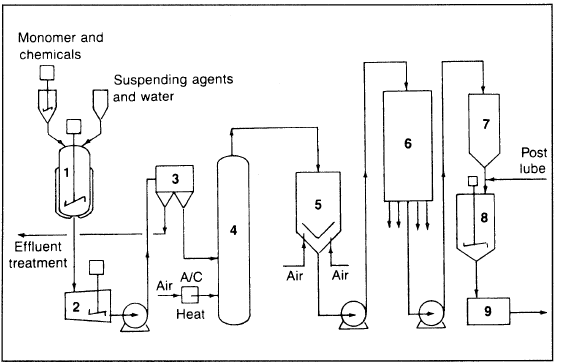
Polystyrene (PS)
 المؤلف:
sami matar & Lewis. F. Hatch
المؤلف:
sami matar & Lewis. F. Hatch
 المصدر:
Chemistry of PETROCHEMICAL PROCESSES
المصدر:
Chemistry of PETROCHEMICAL PROCESSES
 الجزء والصفحة:
p 334
الجزء والصفحة:
p 334
 24-9-2017
24-9-2017
 2306
2306
Polystyrene (PS)
Polystyrene (PS) is the fourth big-volume thermoplastic. Styrene can be polymerized alone or copolymerized with other monomers. It can be polymerized by free radical initiators or using coordination catalysts. Recent work using group 4 metallocene combined with methylaluminoxane produce stereoregular polymer. When homogeneous titanium catalyst is used, the polymer was predominantly syndiotactic. The heterogeneous titanium catalyst gave predominantly the isotactic.
Copolymers with butadiene in a ratio of approximately 1:3 produces SBR, the most important synthetic rubber.
Copolymers of styrene-acrylonitrile (SAN) have higher tensile strength than styrene homopolymers. A copolymer of acrylonitrile, butadiene, and styrene (ABS) is an engineering plastic due to its better mechanical properties (discussed later in this chapter). Polystyrene is produced either by free radical initiators or by use of coordination catalysts.
Bulk, suspension, and emulsion techniques are used with free radical initiators, and the polymer is atactic. In a typical batch suspension process (Figure 1.1), styrene is suspended in water by agitation and use of a stabilizer.

Figure 1.1. The Lummus Crest Inc. process for producing polystyrene: (1) reactor, (2) holding tank (Polystyrene beads and water), (3) centrifuge, (4) pneumatic drier, (5) conditioning tank, (6) screening of beads, (7,8) lubrication and blending, (9) shipping product.
The polymer forms beads. The bead/water slurry is separated by centrifugation, dried, and blended with additives.
 الاكثر قراءة في كيمياء البوليمرات
الاكثر قراءة في كيمياء البوليمرات
 اخر الاخبار
اخر الاخبار
اخبار العتبة العباسية المقدسة


